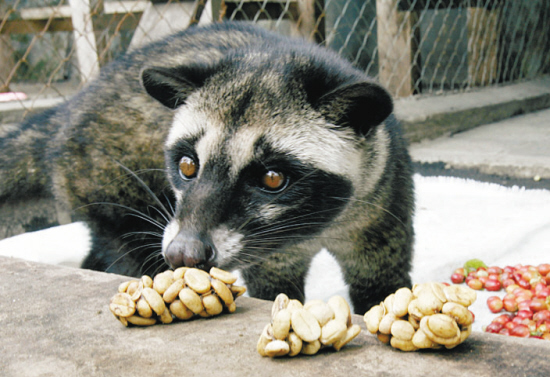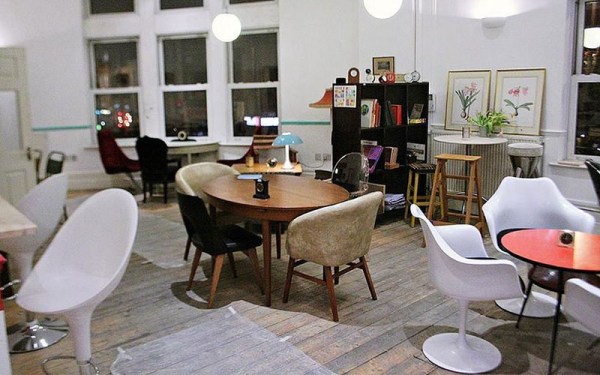The most distinctive ingredient in coffee is caffeine. How can I get a cup of decaf coffee?
Follow the caf é (Wechat official account vdailycom) and found that Beautiful Cafe opened a small shop of its own.
Coffee is one of the three biggest drinks in the world, and it is loved by many people. The most distinctive ingredient in coffee is caffeine, but not everyone likes it. In terms of taste, it is the main source of bitterness of coffee; functionally, it is a nerve stimulant that can keep people in a state of excitement and affect sleep. In addition to caffeine, coffee contains thousands of ingredients that can form unique flavors, many of which have health value. So, remove caffeine from coffee and there is a market demand.
Caffeine dissolves easily in hot water, and it is not difficult to extract it from coffee beans. The hard part is how to just get rid of it and keep the rest of the coffee as much as possible. If water is used, caffeine is extracted as well as a large number of other flavor substances. If you want to preserve the flavor of the coffee as much as possible, use other means to selectively remove the caffeine and add the rest of the extract back.

Such an operation is not easy to implement. Another idea is to choose specific organic solvents, such as dichloromethane, to specifically take away caffeine and leave other substances behind. However, there are always residues of organic solvents, no matter whether their toxicity is low enough or not, "organic solvent residues" always make consumers have doubts.
As early as 1822, a French scholar discovered the "supercritical phenomenon" of matter. In 1879, some scientists discovered the excellent solubility of supercritical fluid and predicted that it could be used as an excellent solvent in industrial production. However, it was not until 1962 that the concept of supercritical extraction finally became a technology and was successfully applied to coffee decaffeination.
We know that all kinds of substances have gas, liquid and solid states. The three states can be transformed into each other at appropriate temperature and pressure. For example, water, at normal pressure, is gaseous above 100 °C, becomes liquid below this boiling point, and becomes solid as low as 0 °C. If you increase the pressure, these transition temperatures will change, for example, at high pressure, water can remain liquid above 100 °C-or above 100 °C, if you increase the pressure, the water vapor can also be liquefied into water. However, if the temperature exceeds 374 °C, no matter how high the pressure is, water vapor cannot be turned into water. But if the pressure is high enough, its density will be much higher than that of gas and close to the density of water. Unlike gases, liquids and solids, this state is called the fourth state of matter-the supercritical state. And that 374 °C is also called "supercritical temperature". Substances in a supercritical state are called "supercritical fluids".
For water, it requires too high temperature and pressure to reach the supercritical state, which is not convenient in actual production. Carbon dioxide, on the other hand, is "friendly" with a supercritical temperature of 31.1 °C. As long as the temperature is higher than this and the pressure is increased to more than 72.8 atmospheres, carbon dioxide becomes a supercritical fluid.

The characteristics of supercritical fluids are very different from those of gases and liquids. Its density is close to that of liquid, but its viscosity is very low, its diffusivity is good, and its surface tension is very low. These characteristics make it have superior extraction ability. The specialty chemical industry uses supercritical carbon dioxide for fully absorbent coffee beans, which can remove 98% of the caffeine.
The advantage of supercritical carbon dioxide extraction is not just high efficiency. More importantly, it has a high selectivity-there are hundreds of beautiful red coffee beans, it only likes caffeine. Carbon dioxide is non-toxic and tasteless. As long as the high pressure is removed, it can be volatilized almost completely. Supercritical carbon dioxide, which extracted caffeine, enters the separation tower and adds water to remove caffeine-caffeine itself is another product, while carbon dioxide can be recycled. Such a process can be called green and environmentally friendly.
Coffee decontamination is the first successful application of supercritical carbon dioxide extraction technology. Since then, this technology has been more widely developed and more and more applied. For example, a similar process can be used to remove caffeine from tea, while changing the process can also extract tea polyphenols from tea. In the beer industry, the extraction of effective components from hops with supercritical carbon dioxide has also been widely used.
The separation of bioactive substances from natural products has a broad prospect in food, medicine, flavor and other industries, such as oils, natural medicine ingredients, essential oils, essence and so on. Like caffeine, the traditional separation methods either use organic solvents, have to face the question of residual organic solvents, or use high-temperature water solution, and then go through some series of separation and purification. In addition to the tedious process, high temperature will also cause a lot of loss of biological activity. Supercritical carbon dioxide extraction with the help of special chemical technology not only has high extraction efficiency and does not have the problem of solvent residue, but also can operate at lower temperature, which can avoid the damage of high temperature to the target substance.
Related readings:
The wonderful use of coffee, pure natural hair dye
Tools and materials: coffee powder, old towels, electric caps
Seeing the people who don't get a stain in Starbucks, I can't help thinking that since coffee has such a powerful dyeing function, it should be leveraged to make hair dye.
Hair dyeing steps:
Add coffee powder to boiling water that keeps your hair completely moist, the higher the concentration, the better. Cool the coffee juice to about 30 degrees Celsius and apply it to your hair. Repeat when your hair dries naturally. But after applying coffee juice this time, you need to wrap your hair in a towel for an hour. In order to have a more obvious effect, you can put on an electric cap to heat it, and then rinse your hair with clean water.
Important Notice :
前街咖啡 FrontStreet Coffee has moved to new addredd:
FrontStreet Coffee Address: 315,Donghua East Road,GuangZhou
Tel:020 38364473
- Prev

Seven unexpected types of coffee are not only refreshing but also have a strong taste.
Coffee is like sushi, it will change as long as you leave your hometown. If you think caffeine doesn't work anymore, try these unexpected, heavy-flavored coffees. 1. Indonesia | Muscat Coffee (Kopi luwak) highlight: Indonesian coconut cat droppings as raw material civet coffee (Kopi Luwak), Kopi (Indonesian, coffee), Luwak is Indonesia
- Next

Not the traditional coffee shop, but the strangest coffee shop in London!
Sometimes cafes not only sell coffee, but also offer a variety of unexpected services. 1. Cereal Cafe (Cereal Killer Caf) Grain Cafe is the first coffee shop in the UK that serves only cereal food, located on Brick Lane Street in London, where customers can order cereal food from all over the world from 7am to 8pm every day. Valley
Related
- What documents do you need to go through to open a coffee shop? coffee shop coffee shop certificate processing process
- How to purchase Coffee beans in small Cafe how to choose a suitable supplier for domestic Coffee supply Company
- How to drink Starbucks Fragrance White Coffee? how to make Australian White Coffee? what Italian coffee beans are recommended?
- The Story of Flora Coffee: the name of Flora Coffee Bean and the implication of the Flowers on Florna Coffee
- How much does a cup of coffee cost? How much is the profit of a cup of coffee? What is the profit of the coffee shop in a year?
- Yunnan small Coffee, known as "fragrant Coffee", introduces the characteristics of Alpine Arabica Coffee producing areas in Yunnan, China
- 2023 latest Starbucks full menu price list how much is a cup of Starbucks coffee what is better to drink the most popular hot and cold drinks recommended
- Starbucks different kinds of Coffee Price list Starbucks menu 2023 Top Ten Best drinks in Starbucks
- Starbucks Spring praise Comprehensive matching Coffee Bean theme Story Packaging implication and taste description
- The cost of a cup of coffee latte American coffee cost price and selling price

